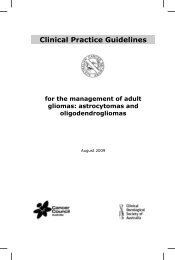Clinical Practice Guidelines for the management of locally advanced ...
Clinical Practice Guidelines for the management of locally advanced ...
Clinical Practice Guidelines for the management of locally advanced ...
You also want an ePaper? Increase the reach of your titles
YUMPU automatically turns print PDFs into web optimized ePapers that Google loves.
Eight trials examined acute toxicity. 52, 53, 55-57, 62, 63, 65 There were no statistically significant increases in<br />
short-term adverse outcomes with single-dose radio<strong>the</strong>rapy o<strong>the</strong>r than <strong>for</strong> <strong>the</strong> flare (p=0.03, Roos<br />
2005 55 ). In one study, more severe toxicity (grade 2–4) was significantly decreased in <strong>the</strong> single<br />
fraction arm (p = 0.02, Hartsell 2005). 56<br />
These results support <strong>the</strong> conclusion that <strong>the</strong>re is no evidence to suggest any dose response <strong>for</strong> initial<br />
pain response rates when comparing a single fraction <strong>of</strong> 8Gy versus multiple fractions ranging from<br />
20Gy/5f to 30Gy/10f. That is, single fraction <strong>of</strong> 8Gy is not worse than a course <strong>of</strong> multi-fraction<br />
treatment <strong>for</strong> <strong>the</strong> endpoint <strong>of</strong> initial pain response. This is in agreement with <strong>the</strong> meta-analysis by Sze<br />
et al 67 and updated, 68 which included additional trials that did not meet <strong>the</strong> inclusion criteria <strong>for</strong> <strong>the</strong>se<br />
guidelines.<br />
Greater patient convenience and lower cost may make single fractions an attractive option <strong>for</strong><br />
treatment even at <strong>the</strong> expense <strong>of</strong> higher re-treatment and fracture rates. However, two studies<br />
demonstrated that a significant proportion <strong>of</strong> patients may prefer multiple fractions if that will result<br />
69, 70<br />
in lower re-treatment and fracture rates.<br />
Evidence summary Level References<br />
Low-dose external beam radio<strong>the</strong>rapy<br />
There are no controlled trials comparing EBRT with no treatment. As<br />
EBRT is a recognised treatment <strong>of</strong> metastatic bone pain, RCTs<br />
comparing radio<strong>the</strong>rapy with no <strong>the</strong>rapy would be considered<br />
unethical. Poorer outcomes at lower doses support <strong>the</strong> notion that<br />
EBRT is an effective treatment <strong>of</strong> metastatic bone pain.<br />
Single versus multi-fraction higher-dose EBRT<br />
No dose response exists <strong>for</strong> pain response rates when comparing a<br />
single fraction <strong>of</strong> 8Gy versus multiple fractions ranging from 20Gy/5f<br />
to 30Gy/10f. That is, a single fraction <strong>of</strong> 8Gy is not worse than a<br />
course <strong>of</strong> multi-fraction treatment <strong>for</strong> <strong>the</strong> endpoint <strong>of</strong> pain response.<br />
Fracture rates following radiation are low (



